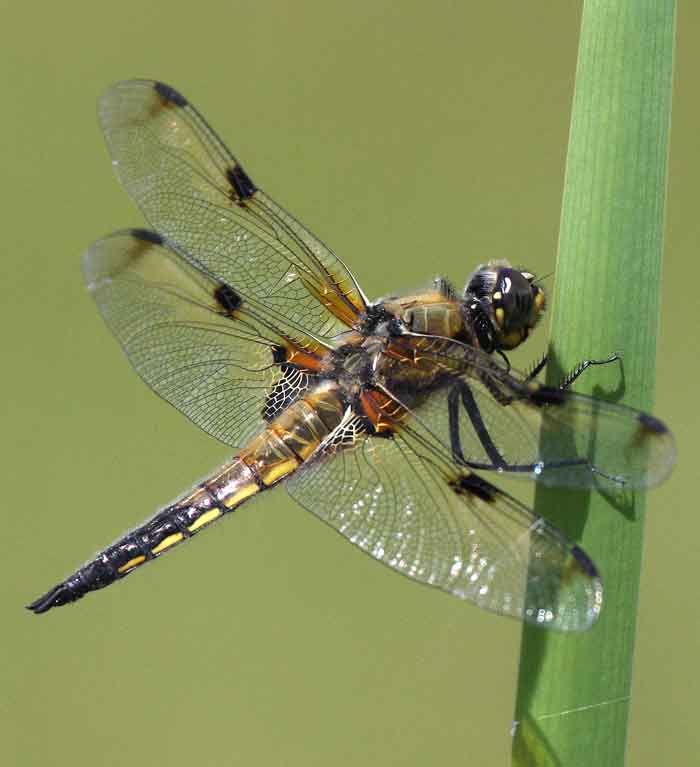
Libellula quadrimaculata (*)
Superregnum: Eukaryota
Cladus: Unikonta
Cladus: Opisthokonta
Cladus: Holozoa
Regnum: Animalia
Subregnum: Eumetazoa
Cladus: Bilateria
Cladus: Nephrozoa
Cladus: Protostomia
Cladus: Ecdysozoa
Cladus: Panarthropoda
Phylum: Arthropoda
Subphylum: Hexapoda
Classis: Insecta
Cladus: Dicondylia
Subclassis: Pterygota
Cladus: Metapterygota
Cladus: Odonatoptera
Cladus: Holodonata
Ordo: Odonata
Subordo: Epiprocta
Infraordo: Anisoptera
Superfamilia: Libelluloidea
Familia: Libellulidae
Subfamilia: Libellulinae
Genus: Libellula
Species: Libellula quadrimaculata
Name
Libellula quadrimaculata Linnaeus, 1758
Synonyms
Libellula quadripunctata Fabricius, 1781
Libellula maculata Harris, 1782
Libellula ternaria Say, 1840 [partim.]
Libellula quadrimaculata asahinai Schmidt, 1957
Libellula relicta Belyshev, 1973
References
Linnaeus, C. 1758. Systema Naturae per regna tria naturae, secundum classes, ordines, genera, species, cum characteribus, differentiis, synonymis, locis. Editio Decima, Reformata. Tomus I. Holmiæ (Stockholm): impensis direct. Laurentii Salvii. 824 pp. DOI: 10.5962/bhl.title.542 BHL Reference page.
Fabricius, J.C. 1781. Species insectorum; exhibentes eorum differentias specificas, synonyma, auctorum, loca natalia, metamorphosin ediectis observationibus, descriptionibus. Carol. Ernest. Bohnii, Hamburg and Kiel, vol 1: VIII + 552 pp. BHL Reference page.
Harris 1780 [1782]. An exposition of English insects. White & Robson, London.
Say, T. 1840. Description of new North American neuropterous insects, and observations on some already described. Journal of the Academy of Natural Sciences of Philadelphia 8 (1839): 9–46.
Schmidt, E. 1957. Ent. Z. 67: 83
Belyshev, B.F. 1973. The dragonflies of Siberia (Odonata) Vol. 1, pt. 2, pp. 337–620. Nauka, Novosibirsk.
Vernacular names
български: Кафяво живениче
čeština: Vážka čtyřskvrnná
Deutsch: Vierfleck
English: Four-spotted Chaser
español: Libélula de cuatro puntos
suomi: Ruskohukankorento
français: Libellule à quatre taches
magyar: Négyfoltos acsa
italiano: Libellula dalle quattro macchie
日本語: ヨツボシトンボ
lietuvių: Keturtaškė skėtė
Nederlands: Viervlek
norsk: Firflekklibelle
polski: Ważka czteroplama
русский: Четырёхпятнистая стрекоза
svenska: Fyrfläckad trollslända
Kiswahili: Fyrfläckad trollslända
中文: 小斑蜻
Libellula quadrimaculata, known in Europe as the four-spotted chaser and in North America as the four-spotted skimmer, is a dragonfly of the family Libellulidae found widely throughout Europe, Asia, and North America.
The adult stage is found between April to early September in the United Kingdom, and from mid-May to mid-August in Ireland. Larvae have a two-year developmental cycle. Adults feed predominantly on mosquitoes, gnats, and midges;[1] the larvae feed primarily on other aquatic insect larvae and on tadpoles.
There is a variant form, praenubila Newman, which has exaggerated wing spots. This is believed to be related to water temperatures during larval development, and appears to be more common in Europe than in the Americas.
The four-spotted skimmer is the state insect of Alaska.[2]
Habitat
This active dragonfly mainly lives by ponds, vernal pools, and slow flowing rivers; they are most common in June and July.
Identification
The brown colour and the four spots on the wings make them unmistakable.
Behaviour
Four-spotted chaser on its perch
The male is considered to be highly aggressive and will defend a given territory from incursions from other males of the species. The male is known to form preferences for prominent perches and will often return to the same perches around the margins of pools and ponds whilst it patrols for intruders. Males have a favourable view of the sky during perching. They look toward a section of the sky away from the sun, with less radiation but a higher UV and blue-violet saturation. Thus, the fovea of the eyes, which is sensitive to blue and UV radiation, is optimally suited to the detection of flying insects against the blue sky.[3] Both sexes are prolific fliers, and mating takes place in the air, rather than on perches or amongst the vegetation. The female lays her eggs on floating vegetation. They tend to be easier to approach than Broad-bodied Chasers.
Predators
The larger emperor dragonfly (Anax imperator) is a predator of this species.[4] Another is the green tiger beetle (Cicindela campestris).[5]
References
http://www.shgresources.com/ak/symbols/insect/ Archived 2009-01-07 at the Wayback Machine Retrieved 16 Feb. 2010
"FAQ ALASKA - Frequently Asked Questions About Alaska". sled.alaska.edu. 17 January 2006. Archived from the original on 10 February 2010. Retrieved 28 January 2010.
Sauseng, Manuela; Pabst, Maria-Anna; Kral, Karl (20 November 2003). "The dragonfly Libellula quadrimaculata (Odonata: Libellulidae) makes optimal use of the dorsal fovea of the compound eyes during perching" (PDF). European Journal of Entomology. 100 (4): 475–479. doi:10.14411/eje.2003.071. ISSN 1210-5759.
"Emperor Dragonfly". Norfolk Dragons. Archived from the original on 27 May 2009. Retrieved 16 February 2010.
"An Unexpected Predator of the Four Spot Chaser Dragonfly". 23 January 2009. Archived from the original on 17 November 2017. Retrieved 15 February 2010.
"Libellula quadrimaculata". Integrated Taxonomic Information System. Retrieved 9 February 2006.
Retrieved from "http://en.wikipedia.org/"
All text is available under the terms of the GNU Free Documentation License

